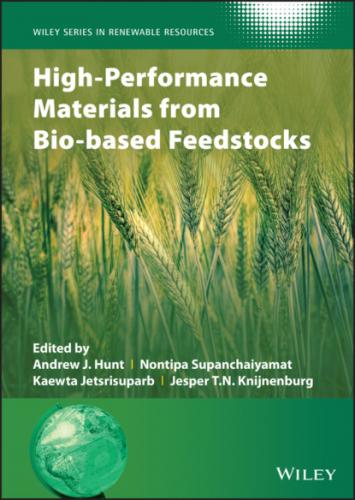From the preceding equation, the number of carbon atoms can vary according to the reaction conditions such as temperature and pressure. For instance, the use of a reaction temperature of 400 °C, which is slightly higher than the theoretically required 360 °C, presents the incomplete decomposition of cellulose through Eq. (2.2).
Previous research showed that with the aim to produce a biochar with high porosity and surface area, the process should be operated at temperatures in the range of 600–800 °C [41]. A type of pinewood, Pinus sylvestris, was pyrolyzed at various reaction temperatures, and increasing temperature enhanced the porosity and surface area of the obtained carbonaceous product. Pyrolysis at 500 °C generated a biochar with a surface area of 19 m2 g−1, while increasing the temperature to 600 and 700 °C greatly improved the surface area to 254 and 470 m2 g−1, respectively. Conversely, the pyrolysis of non‐lignocellulosic material at temperatures above 700 °C resulted in a decrease in surface area due to the collapse of the biochar structure [42]. The change in pore diameter depends on several parameters, e.g. type of raw material and heating rate. An increase in carbonization temperature strongly enhanced the number of pores but it slightly affected the pore diameter. However, with the biomass having low lignin content or low hardness, increasing the carbonization temperature could significantly increase the pore diameter of biochar. This clearly shows that the carbonization and pyrolysis processes benefit the porosity of biochar, which is an interesting characteristic for catalysis application. However, the production of biochar via these thermochemical processes has some disadvantages as it reduces the amount of valuable chemical groups. Biomass commonly consists of oxygen‐containing functional groups with carbon–oxygen bonds (C–O), carbonyl groups (C=O), and hydroxyl groups (–OH), which are useful in many catalytic processes. An increase in carbonization temperature led to a decrease in such chemical functionalities [43]. For this reason, the physical and chemical properties of the biochar should be modified prior to its use in specific applications including catalysis. For example, mixtures of rapeseed oil cake and walnut shells were carbonized at 400 and 750 °C. Only a few functional groups appeared on the surface of the produced biochar, and either chemical (using agents such as ammonium and monoethanolamide) or thermal treatment were required before use in CO2 capture [44].
2.3.2 Activation
The activation process is an oxidation reaction at elevated temperatures. The objective of the activation process is to enhance the surface area, pore size, and pore volume of the bio‐based carbon material during carbonization, as the highly porous structure of carbon material is advantageous in several applications such as adsorption and catalysis. In order to clarify the distinction between carbonization and activation, the latter process requires both an activating agent and heat. Activation is performed under an oxygen‐free or oxygen‐poor atmosphere depending on the type of activating agent. The product obtained from the activation process is a so‐called activated carbon, which is a highly porous carbon‐rich material. Lignocellulosic materials are promising raw materials for the production of activated carbons since they can provide a great yield of activated carbon together with high porosity and hardness compared to non‐lignocellulosic materials. Previous research showed that activated carbon prepared from lignocellulosic biomass had a surface area in the range of 300–2700 m2 g−1 and various pore sizes [21, 45]. Conventionally, there are two routes in the activation process. First, biomass is carbonized to reduce moisture, volatile matter, and contaminants, and the obtained biochar is subsequently activated with an oxidizing agent and carbonized again. This route can be called a two‐step activation process [46]. A different route is where the biomass is directly activated during the carbonization step, which is a one‐step activation process [28, 39]. The activation method is typically classified into two types depending upon the kind of activating agent employed, and these are chemical and physical activation.
2.3.2.1 Chemical Activation
The utilization of agricultural material as a raw material for the production of activated carbon is usually carried out by chemical activation. The proper temperature for chemical activation should be 400–600 °C. As the chemical activating agent should penetrate and erode the cellulose and lignin and destroy their structures during carbonization, the property of the activating agent should be strongly corrosive. Not only strong acidic and basic agents but also other strong oxidizing agents have been exploited. The most widely used chemical activating agents are potassium hydroxide (KOH), phosphoric acid (H3PO4), and zinc chloride (ZnCl2) [45, 47], but chemical agents such as sodium chloride (NaCl), sodium hydroxide (NaOH), hydrogen peroxide (H2O2), and potassium carbonate (K2CO3) have also been used [48–50]. The chemical activating agents in an aqueous form are typically applied onto the raw materials via impregnation for a desired period of time. The duration of the chemical activation is often around 60–120 minutes, and the ratio of chemical activating agent and raw material is usually between 1 : 1 and 5 : 1. The reaction pathways when using KOH as an activating agent are presented in Eqs. (2.3)–(2.6) as follows [26]:
(2.5)
The activated carbon produced from soybean pods activated by KOH showed the highest surface area of 2245 m2 g−1 [47]. An interesting shortcut in the reaction pathways was taken by employing K2CO3 as an activating agent instead of KOH [48]. The K2CO3 is an initial substance in Eq. (2.4), thus Eq. (2.3) could be eliminated. The activated carbon produced by using K2CO3 also showed an extremely high surface area of 2613 m2 g−1 along with a high pore volume of 1.66 cm3 g−1. However, the KOH showed a higher activation potential than the K2CO3 at low carbonization temperatures with regard to the porosity and surface area of the resulting activated carbon [51], which was ascribed to the difference in melting point. The K2CO3 has a higher melting temperature of 890 °C while the melting point of KOH is 360 °C. When using NaOH as an activating agent, the reaction pathways are presented in Eqs. (2.7)
